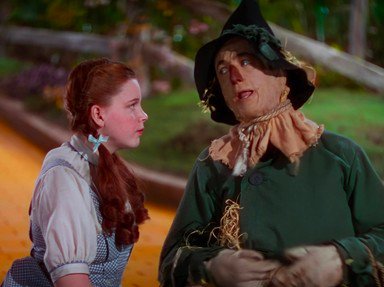Quiz Answer Key and Fun Facts
1. Is it true that the film was initially a box office failure?
2. The transition to colour in the film occurs just before Dorothy opens the door to the farmhouse, and not after she has stepped outside, as is commonly thought. This transition was hidden in the film's original colours of sepia, but becomes obvious when shown in black and white. Which coloured part of Dorothy's lounge room gives this away?
3. What was Toto's name in real life?
4. Samuel Goldwyn, who owned the rights to the novel, had toyed with the idea of giving the role of the scarecrow to another actor. Who was that actor?
5. Three extra songs were included in the shooting of the film, but these were cut before the film was released. One was called "The Jitterbug", and the second was a reprise of "Ding! Dong! The Witch is Dead". The third was a reprise of another song heard earlier in the film. What was that song?
6. The plot for "The Wizard of Oz" was re-written many times by various writers before the final version hit the screen. Many peculiar ideas were broached, but then quickly discarded. Two of these fortunately discarded ideas included hints of a romance between Dorothy and the Scarecrow - and what else?
7. Dorothy's ruby slippers are now considered to be one of the most valuable pieces of film history. Yet in the book on which the film is based, they weren't coloured ruby at all. What was their original colour?
8. We all know that actor Buddy Ebsen had commenced work on the film as the Tin man, and had to pull out because of his allergy to the body paint he had to wear for the role - but who was intended to originally play the Wizard of Oz?
9. So much precise and painstaking detail was paid to every colour in the film that the studio's art department often spent long hours arguing over every detail. An entire week, for example, was spent debating the colour of which feature of the film?
10. The Wicked Witch of the West died in the film, but in real life, which of the major stars in the film was the last to pass away?
Source: Author
Creedy
This quiz was reviewed by FunTrivia editor
skunkee before going online.
Any errors found in FunTrivia content are routinely corrected through our feedback system.

